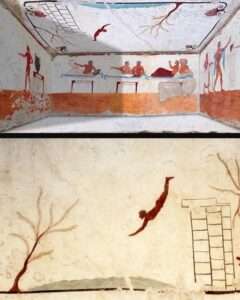The Tomb of the Diver, dating back to approximately 470 BCE, is a fascinating ancient Greek burial site situated near the city of Paestum in southern Italy. Comprised of five local limestone slabs, this tomb is distinguished by its structure, featuring four lateral walls and a roof, with the floor carved directly into the natural bedrock. What truly sets this tomb apart is its exceptionally well-preserved frescoes, providing a rare window into the realm of ancient Greek artistry.

Adorning the four side walls are depictions of a symposium—a customary Greek drinking gathering—showcasing reclining figures and attentive attendants. However, it is the ceiling that holds the most intriguing imagery: a solitary figure captured in mid-dive into water, a symbol that continues to captivate scholars and serves as the inspiration behind the tomb’s modern epithet.
Executed through the true fresco technique, where pigments are applied onto damp plaster, the frescoes boast a vibrant and lasting allure as the colors meld seamlessly with the drying wall. The artist’s choice of a restrained palette, predominantly featuring black and red shades interwoven with hints of green, blue, and white, imbues these scenes with a striking vibrancy.
The Tomb of the Diver serves as a rare testament to Greek painting as it existed during the Orientalizing, Archaic, or Classical eras, having endured the passage of time in its complete form. Its unearthing in 1968 by the esteemed Italian archaeologist Mario Napoli has not only shed light on ancient Greek funerary customs but also enriched our understanding of artistic expression prevalent during that period.





